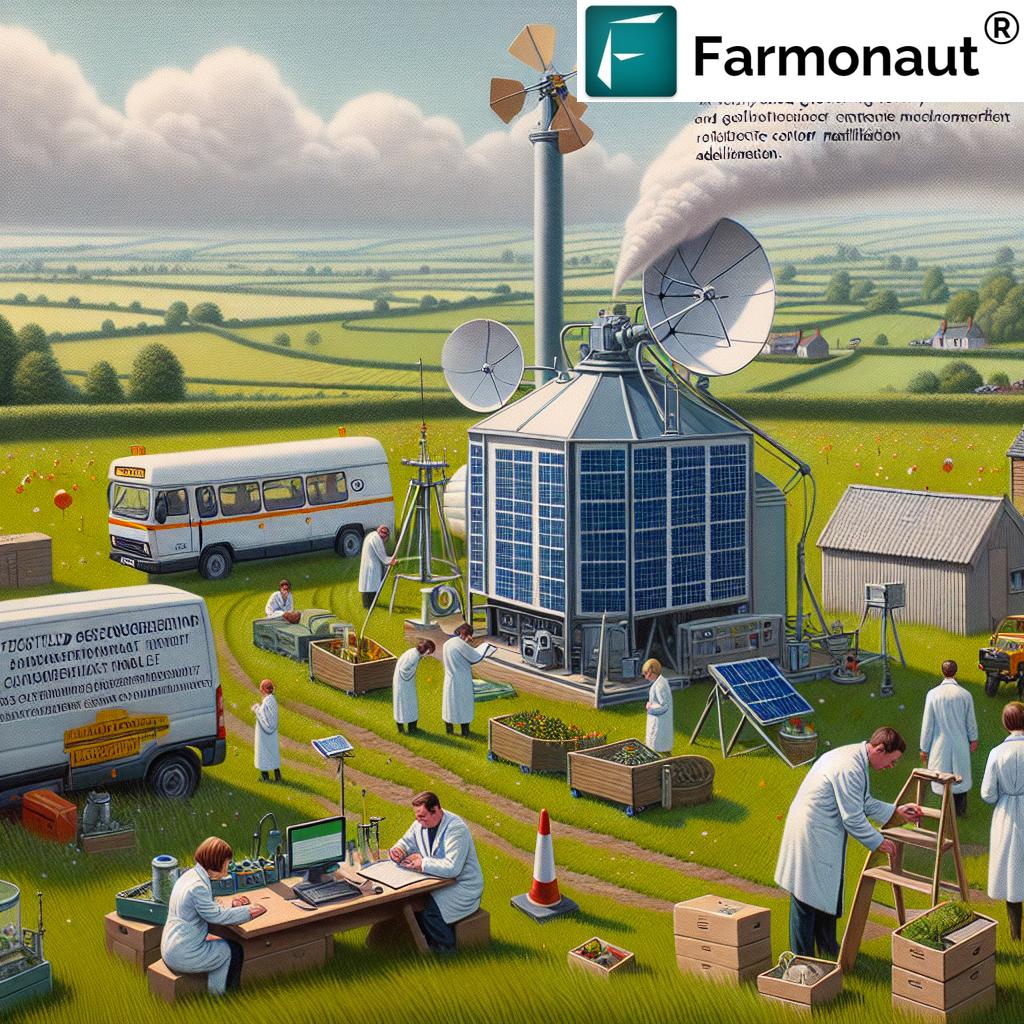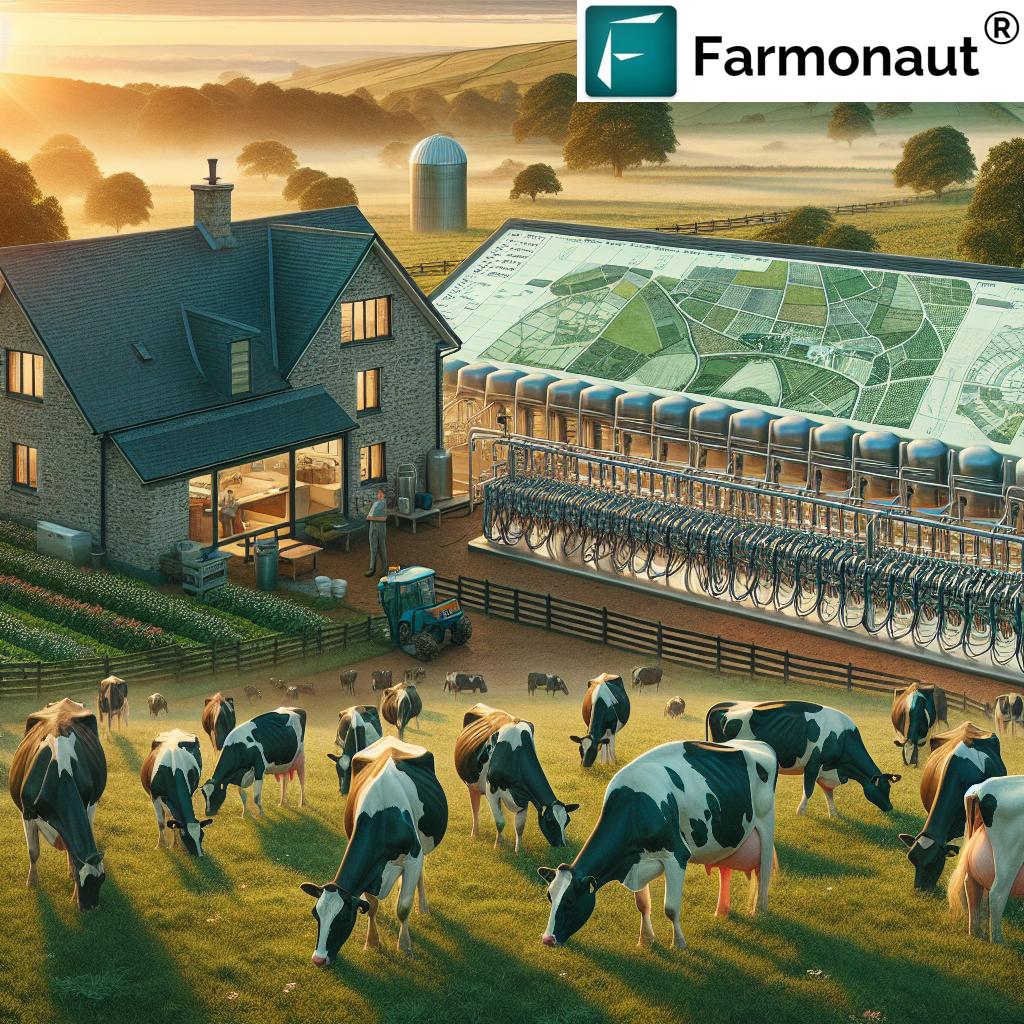Sustainable Organic Dairy Farming: Mastering Clean Grazing and Worm Prevention in England and Wales
“Rotational grazing can increase pasture productivity by up to 30% compared to continuous grazing systems.”
Welcome to our comprehensive guide on sustainable organic dairy farming, with a focus on mastering clean grazing practices and effective worm prevention strategies in England and Wales. As we delve into this crucial topic, we’ll explore innovative grassland management techniques that are revolutionizing the organic dairy industry. Our goal is to provide you with valuable insights that will help improve your farm’s productivity, sustainability, and overall health of your livestock.

The Importance of Sustainable Livestock Management
In the ever-evolving world of agriculture, sustainable livestock management has become a cornerstone of successful organic dairy farming. We understand that as farmers in England and Wales, you face unique challenges in maintaining the health of your herds while adhering to organic standards. That’s why we’re here to guide you through the latest trends and techniques in grassland management strategies and clean grazing practices.
Sustainable livestock management is not just about meeting organic certifications; it’s about creating a harmonious system where your cattle thrive, your land flourishes, and your farm remains profitable. By implementing innovative clean grazing practices and integrated parasite management techniques, we can revolutionize organic farm profitability while maintaining the highest standards of animal welfare and environmental stewardship.
Understanding Clean Grazing Practices
Clean grazing is a fundamental concept in organic dairy farming that focuses on minimizing parasite exposure to livestock, particularly young and susceptible animals. This practice is crucial for maintaining herd health and reducing the reliance on chemical wormers, which is a key aspect of organic farming principles.
- Rotational Grazing: This involves dividing pastures into smaller paddocks and moving cattle regularly to prevent overgrazing and reduce parasite build-up.
- Pasture Rest Periods: Allowing fields to rest between grazing cycles helps break parasite lifecycles and promotes healthier grass growth.
- Mixed Species Grazing: Alternating between different livestock species can help control parasites that are specific to certain animals.
By implementing these clean grazing practices, we can significantly reduce the worm burden in our herds while improving pasture health and productivity. This approach is not only beneficial for animal health but also contributes to the overall sustainability of our farming operations.
Integrated Parasite Management in Organic Farming
Integrated parasite management is a holistic approach to controlling worms and other parasites in organic dairy cattle. This method combines various strategies to create a comprehensive parasite control plan without relying heavily on chemical interventions.
- Monitoring and Diagnostics: Regular fecal egg counts and pasture larval counts to assess parasite levels.
- Selective Treatment: Targeting only those animals that show signs of parasitic infection or have high egg counts.
- Breeding for Resistance: Selecting cattle with natural resistance to parasites can help build a more resilient herd over time.
- Nutritional Management: Ensuring a well-balanced diet to support the animal’s natural immune defenses against parasites.
By adopting these integrated parasite management techniques, we can effectively control worms in our dairy cattle while adhering to organic farming principles. This approach not only helps in maintaining animal health but also contributes to the long-term sustainability of our farms.
Rotational Grazing Benefits
Rotational grazing is a cornerstone of sustainable organic dairy farming, offering numerous benefits for both the land and the livestock. This method involves dividing pastures into smaller sections and systematically moving cattle through these areas, allowing for optimal grass utilization and recovery.
- Improved Pasture Health: By preventing overgrazing, rotational grazing allows grass to recover fully, leading to deeper root systems and more robust plant growth.
- Enhanced Soil Quality: The movement of cattle helps distribute manure evenly, improving soil fertility and structure.
- Increased Forage Yield: Well-managed rotational grazing can significantly increase the amount of forage produced per acre.
- Better Worm Control: Regular movement of cattle disrupts parasite lifecycles, reducing the overall worm burden in the herd.
Implementing a rotational grazing system requires careful planning and management, but the benefits far outweigh the initial effort. By adopting this practice, we can significantly improve our pasture health while effectively controlling worms in our dairy cattle.

Improving Pasture Health for Organic Farm Profitability
Healthy pastures are the foundation of a successful organic dairy farm. By focusing on improving pasture health, we can increase organic farm profitability while maintaining sustainable practices. Here are some key strategies to enhance your grassland:
- Soil Testing and Amendment: Regular soil tests help identify nutrient deficiencies, allowing for targeted organic amendments.
- Diverse Seed Mixes: Planting a variety of grass and legume species can improve overall pasture resilience and nutritional value.
- Proper Grazing Management: Implementing rotational grazing and avoiding overgrazing to maintain plant health and productivity.
- Weed Control: Using organic methods to manage weeds, such as mechanical removal or strategic grazing.
By investing in pasture health, we not only provide better nutrition for our dairy cattle but also create a more sustainable and profitable farming system. Healthy pastures require less input, produce more forage, and contribute to better milk quality and yield.
“Organic dairy farms implementing clean grazing techniques can reduce anthelmintic use by 50-80% in cattle.”
Worm Prevention Strategies for Dairy Cattle
Effective worm prevention is crucial for maintaining healthy dairy cattle and ensuring optimal milk production. In organic farming, where the use of chemical wormers is limited, implementing preventive strategies becomes even more important. Here are some key approaches to worm prevention in dairy cattle:
- Clean Grazing System: Implementing a grazing plan that minimizes exposure to parasite larvae, especially for young and susceptible animals.
- Quarantine and Testing: Isolating and testing new animals before introducing them to the herd to prevent bringing in new parasites.
- Monitoring Body Condition: Regularly assessing the body condition of cattle can help identify animals that may be suffering from parasite infections.
- Pasture Management: Maintaining appropriate grass height and avoiding overgrazing to reduce the concentration of parasite larvae on pastures.
By implementing these worm prevention strategies, we can significantly reduce the parasite burden in our dairy herds without relying heavily on chemical interventions. This approach not only aligns with organic farming principles but also contributes to the overall health and productivity of our cattle.
Leveraging Technology in Organic Dairy Farming
In today’s digital age, technology plays a crucial role in enhancing organic dairy farming practices. One such innovative solution is provided by Farmonaut, a pioneering agricultural technology company that offers advanced, satellite-based farm management solutions. These digital tools can significantly improve our ability to manage pastures, monitor herd health, and implement effective clean grazing strategies.
Farmonaut’s platform provides valuable services such as real-time crop health monitoring, AI-based advisory systems, and resource management tools. By leveraging these technologies, we can make more informed decisions about grazing rotations, pasture health, and overall farm management.
To explore how Farmonaut can enhance your organic dairy farming practices, visit their web application or download their mobile apps:
For those interested in integrating Farmonaut’s data into their own systems, check out their API and API Developer Docs.
Comparison of Clean Grazing Techniques
To help you make informed decisions about implementing clean grazing practices on your organic dairy farm, we’ve compiled a comparison table of various techniques:
| Grazing Technique | Worm Prevention Effectiveness | Pasture Recovery Time | Milk Yield Impact | Soil Health Improvement | Implementation Complexity | Cost-Effectiveness |
|---|---|---|---|---|---|---|
| Rotational Grazing | 70% reduction | 20-30 days | 10-15% increase | High | Medium | High |
| Strip Grazing | 60% reduction | 15-25 days | 8-12% increase | Medium | Low | Medium |
| Leader-Follower | 65% reduction | 25-35 days | 12-18% increase | High | High | Medium |
| Deferred Grazing | 75% reduction | 40-60 days | 5-10% increase | Very High | Medium | Low |
This comparison highlights the various aspects of different clean grazing techniques, allowing you to choose the most suitable method for your farm’s specific needs and conditions.
Implementing Clean Grazing Practices: A Step-by-Step Guide
Implementing clean grazing practices on your organic dairy farm requires careful planning and execution. Here’s a step-by-step guide to help you get started:
- Assess Your Land: Conduct a thorough assessment of your pastures, including soil quality, grass species, and topography.
- Divide Pastures: Segment your grazing land into smaller paddocks to facilitate rotational grazing.
- Create a Grazing Calendar: Develop a schedule for rotating cattle through different paddocks, ensuring adequate rest periods for each area.
- Monitor Grass Height: Keep track of grass growth and adjust grazing times accordingly to prevent overgrazing.
- Implement Water Systems: Ensure each paddock has access to clean water to support the rotational grazing system.
- Train Staff: Educate your team on the principles of clean grazing and the importance of adhering to the rotation schedule.
- Regular Health Checks: Monitor your herd for signs of parasitic infections and conduct regular fecal egg counts.
- Adapt and Improve: Continuously assess the effectiveness of your clean grazing system and make adjustments as needed.
By following these steps, you can establish an effective clean grazing system that promotes both pasture health and cattle well-being, while significantly reducing the risk of parasitic infections.
The Role of Nutrition in Worm Prevention
Proper nutrition plays a crucial role in supporting the natural immune defenses of dairy cattle against parasitic infections. A well-balanced diet not only helps maintain overall health but also enhances the animal’s ability to resist and cope with worm infestations. Here are some key nutritional strategies for worm prevention:
- High-Quality Forage: Ensure access to nutritious, diverse pastures that provide a range of essential nutrients.
- Protein Supplementation: Adequate protein intake is crucial for maintaining a strong immune system.
- Trace Mineral Balance: Minerals like copper and zinc play important roles in parasite resistance.
- Probiotic Support: Promoting a healthy gut microbiome can enhance overall immunity and resilience against parasites.
By focusing on nutrition as part of our worm prevention strategy, we can build healthier, more resilient herds that are better equipped to withstand parasitic challenges naturally.
Monitoring and Adapting Your Clean Grazing Plan
A successful clean grazing plan requires ongoing monitoring and adaptation. As farmers, we need to be responsive to changes in weather, pasture conditions, and herd health. Here are some key aspects to monitor:
- Pasture Recovery: Regularly assess grass regrowth and adjust grazing rotations accordingly.
- Cattle Performance: Monitor milk yield, body condition scores, and overall health to gauge the effectiveness of your grazing plan.
- Soil Health: Conduct periodic soil tests to ensure your pastures are maintaining optimal nutrient levels.
- Parasite Levels: Use fecal egg counts and pasture larval counts to track parasite populations and adjust your prevention strategies as needed.
By staying vigilant and adaptable, we can ensure that our clean grazing practices remain effective and continue to support sustainable organic dairy farming.
The Economic Benefits of Clean Grazing
Implementing clean grazing practices not only improves herd health and pasture quality but also offers significant economic benefits for organic dairy farms. Let’s explore how these practices can positively impact your farm’s bottom line:
- Reduced Veterinary Costs: By lowering the incidence of parasitic infections, clean grazing can significantly decrease the need for veterinary interventions.
- Improved Milk Production: Healthier cows with lower parasite burdens typically produce more milk, increasing overall farm output.
- Lower Feed Costs: Well-managed pastures provide higher quality forage, potentially reducing the need for expensive supplemental feeds.
- Increased Land Productivity: Clean grazing practices can improve pasture health and yield, allowing you to support more cattle on the same amount of land.
- Premium Product Potential: Organic milk produced through sustainable practices may command higher prices in the market, enhancing farm profitability.
By embracing clean grazing techniques, we can create a more resilient and profitable organic dairy farming system that benefits both our businesses and the environment.
Challenges and Solutions in Implementing Clean Grazing
While clean grazing offers numerous benefits, it’s important to acknowledge and address the challenges that may arise during implementation. Here are some common issues and their potential solutions:
- Challenge: Initial costs of fencing and water systems for rotational grazing.
Solution: Consider phased implementation and explore government grants or subsidies for sustainable farming practices. - Challenge: Increased labor requirements for moving cattle and managing rotations.
Solution: Invest in training for staff and consider automated gates or mobile water systems to streamline the process. - Challenge: Maintaining consistent forage quality across different paddocks.
Solution: Implement diverse seeding strategies and regular soil testing to ensure uniform pasture quality. - Challenge: Adapting to weather fluctuations that affect grazing schedules.
Solution: Develop flexible grazing plans and consider using tools like Farmonaut for real-time weather and pasture health monitoring.
By anticipating these challenges and preparing appropriate solutions, we can smooth the transition to a clean grazing system and maximize its benefits for our organic dairy farms.
The Future of Organic Dairy Farming in England and Wales
As we look to the future of organic dairy farming in England and Wales, it’s clear that sustainable practices like clean grazing will play an increasingly important role. The industry is evolving, driven by consumer demand for ethical and environmentally friendly products, as well as the need for more resilient farming systems in the face of climate change.
Key trends shaping the future of organic dairy farming include:
- Technological Integration: Increased use of precision agriculture tools, like those offered by Farmonaut, to optimize farm management.
- Biodiversity Focus: Greater emphasis on enhancing on-farm biodiversity to support ecosystem services and resilience.
- Carbon Sequestration: Exploring the potential of pastures and grazing management in carbon capture and storage.
- Consumer Transparency: Leveraging technology to provide greater traceability and information about farming practices to consumers.
By embracing these trends and continuing to innovate in our clean grazing and worm prevention strategies, we can ensure a sustainable and prosperous future for organic dairy farming in England and Wales.
Conclusion
Mastering clean grazing practices and effective worm prevention strategies is essential for the success and sustainability of organic dairy farming in England and Wales. By implementing rotational grazing, integrated parasite management, and leveraging technology like Farmonaut’s solutions, we can significantly improve pasture health, animal welfare, and farm profitability.
Remember, sustainable organic dairy farming is not just about meeting certification requirements; it’s about creating a harmonious system that benefits the land, the animals, and the farmer. As we continue to face challenges such as climate change and evolving consumer preferences, our commitment to innovative and sustainable practices will be key to the long-term success of our farms.
We encourage you to explore the resources and tools mentioned in this guide, including Farmonaut’s digital solutions, to enhance your farm’s efficiency and sustainability. By working together and sharing knowledge, we can build a resilient and thriving organic dairy industry in England and Wales.
FAQ Section
Q: What is clean grazing, and why is it important for organic dairy farming?
A: Clean grazing is a practice that minimizes livestock exposure to parasites by strategically managing pasture use. It’s crucial for organic dairy farming as it helps maintain animal health and reduce reliance on chemical wormers, aligning with organic principles.
Q: How does rotational grazing benefit organic dairy farms?
A: Rotational grazing improves pasture health, increases forage yield, enhances soil quality, and helps control parasites. It leads to better pasture utilization and can increase overall farm productivity.
Q: What are some effective worm prevention strategies for organic dairy cattle?
A: Effective strategies include implementing clean grazing systems, regular monitoring and testing, maintaining proper nutrition, and using selective breeding for parasite resistance.
Q: How can technology like Farmonaut help in organic dairy farming?
A: Farmonaut provides satellite-based farm management solutions that can help monitor pasture health, optimize grazing rotations, and improve overall farm efficiency through real-time data and insights.
Q: What are the economic benefits of implementing clean grazing practices?
A: Clean grazing can lead to reduced veterinary costs, improved milk production, lower feed costs, increased land productivity, and the potential for premium pricing on organic dairy products.















